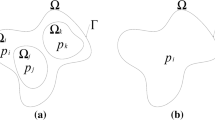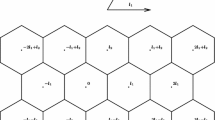Abstract
The development of one-dimensional Turing patterns characteristic of the chlorite-iodide-malonic acid/starch reaction as well as analogous Brussellator/immobilizer and Schnackenberg/immobilizer model systems is investigated by means of a weakly nonlinear stability analysis applied to the appropriately scaled governing equations. Then the theoretical predictions deduced from these pattern formation studies are compared with experimental evidence relevant to the Turing diffusive instabilities under examination in order to explain more fully the transition to such stationary symmetry-breaking spatial structures when the temperature or pool species concentrations vary.
Similar content being viewed by others
References
Amato, I.: A chemical loom weaves new patterns. Science 261, 165 (1993)
Castets, V., Dulos, E., Boissonade, J., De Kepper, P.: Experimental evidence of a sustained standing Turing-type nonequilibrium chemical pattern. Phys. Rev. Lett. 64, 2953–2956 (1990)
De Kepper, P., Castets, V., Dulos, E., Boissonade, J.: Turing-type chemical patterns in the chlorite-iodide-malonic acid reaction. Physica D 49, 161–169 (1991)
Di Prima, R. C., Eckhaus, W., Segel, L. A.: Nonlinear wavenumber interaction in near-critical two-dimensional flows. J. Fluid Mech. 49, 705–744 (1971)
Drazin, R. G., Reid, W. H.: Hydrodynamic Stability. Cambridge: Cambridge University Press (1981)
Dufiet, V., Boissonade, J.: Conventional and unconventional Turing patterns. J. Chem. Phys. 96, 664–672 (1992)
Edelstein-Keshet, L.: Mathematical models in biology. New York: Random House (1988)
Epstein, I. R., Lengyel, I., Kadar, S., Kagan, M., Yokoyama, M.: New systems for pattern formation studies. Physica A 188, 26–33 (1992)
Graham, M. D., Kevrekidis, I. G., Asakura, K., Lauterbach, J., Krischer, K., Rotermund, H.-H., Ertl, G.: Effects of boundaries on pattern formation: Catalytic oxidation of CO on platinum. Science 264, 80–82 (1994)
Guslander, J., Field, R. J.: Modeling of an observed Turing structure in the ClO2 −-I−-Malonic Acid system. Int. J. Bifurcation and Chaos 1, 929–931 (1991)
Harrison, L. G.: Kinetic Theory of Living Patterns. New York: Cambridge University Press (1993)
Hunding, A., Sørensen, P. G.: Size adaptation of Turing prepatterns. J. Math. Biol. 26, 27–39 (1988)
Lee, K. J., McCormick, W. D., Ouyang, Q., Swinney, H.L.: Pattern formation by interacting chemical fronts. Science 261, 192–194 (1993)
Lengyel, L, Epstein, I. R.: Modeling of Turing structures in the chlorite-iodide-malonic acid-starch reaction system. Science 251, 650–652 (1991)
Lengyel, L, Epstein, I. R.: A chemical approach to designing Turing patterns in reaction-diffusion systems. Proc. Natl. Acad. Sci. USA 89, 3977–3979 (1992)
Lengyel, L, Kádár, S., Epstein, I. R.: Quasi-two-dimensional Turing patterns in an imposed gradient. Phys. Rev. Lett. 69, 2729–2732 (1992)
Lengyel, L, Kádár, S., Epstein, I. R.: Transient Turing structures in a gradient-free closed system. Science 259, 493–495 (1993)
Lengyel, L, Rabai, G., Epstein, I. R.: Batch oscillation in the reaction of chlorine dioxide with iodine and malonic acid. J. Amer. Chem. Soc. 112, 4606–4607 (1990a)
Lengyel, I., Rabai, G., Epstein, I. R.: Experimental and modeling study of oscillations in the chlorine dioxide-iodine-malonic acid reaction. J. Amer. Chem. Soc. 112, 9104–9110 (1990b)
Luo, Y.: Private communication (1994)
Malkus, W. V. R., Veronis, G.: Finite amplitude cellular convection. J. Fluid Mech. 4, 225–260 (1958)
Murray, J. D.: Mathematical Biology. Berlin: Springer-Verlag (1989)
Murray, J. D.: Discussion: Developmental biology: Turing theory of morphogenesis — its influence on modelling biological pattern and form. Bull. Math. Biol. 52, 119–152 (1990)
Niehrs, C., Steinbeisser, H., De Robertis, E. M.: Mesodermal patterning by a gradient of the vertebrate homeobox gene goosecoid. Science 263, 817–820 (1994)
Noszticzius, Z., Ouyang, Q., McCormick, W. D., Swinney, H. L.: Effect of Turing pattern indicators on CIMA oscillators. J. Phys. Chem. 96, 6302–6307 (1992)
Othmer, H. G., Scriven, L. E.: Interaction of reaction and diffusion in open systems. Ind. & Eng. Chem. Fund. 8, 302–313 (1969)
Ouyang, Q., Swinney, H. L.: Transition from a uniform state to hexagonal and striped Turing patterns. Nature 352, 610–612 (1991a)
Ouyang, Q., Swinney, H. L.: Transition to chemical turbulence. Chaos 1, 411–420 (1991b)
Ouyang, Q., Gunaratne, G.H., Swinney, H. L.: Rhombic patterns: Broken hexagonal symmetry. Chaos 3, 707–711 (1993)
Ouyang, Q., Noszticzius, Z., Swinney, H. L.: Spatial bistability of two-dimensional Turing patterns in a reaction-diffusion system. J. Phys. Chem. 96, 6773–6776 (1992)
Pearson, J. E.: Pattern formation in a (2 + 1)-species activator-inhibitor-immobilizer system. Physica A 188, 178–189 (1992)
Pearson, J. E.: Complex patterns in simple systems. Science 261, 189–192 (1993)
Pool, R.: Did Turing discover how the leopard got its spots? Science 251, 627 (1991)
Prigogine, L, Lefever, R.: Symmetry breaking instabilities in dissipative systems II. J. Chem. Phys. 48, 1695–1700 (1968)
Schnackenberg, J.: Simple chemical reaction systems with limit cycle behavior. J. Theor. Biol. 81, 389–400 (1979)
Segel, L. A., Jackson, J. L.: Dissipative structure: an explanation and an ecological example. J. Theor. Biol. 37, 545–559 (1972)
Segel, L. A., Levin, S. A.: Applications of nonlinear stability theory to the study of the effects of diffusion on predator-prey interactions. In: Piccirelli, R. A. (ed) Topics in Statistical Mechanics and Biophysics. A Memorial to Julius L. Jackson. AIP Conf. Proc. No. 27, pp. 123–152. New York: Amer. Inst. Phys. 1976
Slater, J. C.: Introduction to Chemical Physics. New York: Dover (1970)
Streitwieser, A., Heathcock, C. H.: Introduction to Organic Chemistry. New York: MacMillan 1985
Stuart, J. T.: On the nonlinear mechanics of wave disturbances in stable and unstable parallel flows, Part 1. The basic behavior in plane Poiseuille flow. J. Fluid Mech. 1, 353–370 (1960)
Swinney, H. L., Krinsky, V. I.: Waves and Patterns in Chemical and Biological Media. Cambridge, MA.: MIT Press (1992) [Reprinted from Physica D 49, 1–256 (1991)]
Turing, A. M.: The chemical basis of morphogenesis. Phil. Trans. R. Soc. Lond. B237, 37–72 (1952)
Watson, J.: On the nonlinear mechanics of wave distrubances in stable and unstable parallel flows, Part 2. The development of a solution for plane Poiseuille and for plane Couette flow. J. Fluid Mech. 9, 371–389 (1960)
Winfree, A. T.: Chemical waves: Crystals from dreams. Nature 352, 568–569 (1991)
Wollkind, D. J., Collings, J. B., Barba, M. C. B.: Diffusive instabilities in a one-dimensional model system for a mite predator-prey interaction on fruit trees: Dispersal motility and aggregative preytaxis effects. J. Math. Biol. 29, 339–362 (1991)
Wollkind, D. J., Manoranjan, V. S., Zhang, L.: Weakly nonlinear stability analyses of prototype reaction-diffusion model equations. SIAM Review 36, 176–214 (1994)
Author information
Authors and Affiliations
Rights and permissions
About this article
Cite this article
Stephenson, L.E., Wollkind, D.J. Weakly nonlinear stability analyses of one-dimensional Turing pattern formation in activator-inhibitor/immobilizer model systems. J. Math. Biol. 33, 771–815 (1995). https://doi.org/10.1007/BF00187282
Received:
Revised:
Issue Date:
DOI: https://doi.org/10.1007/BF00187282




